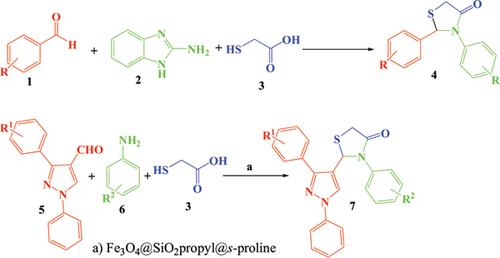Current Organic Synthesis ( IF 1.7 ) Pub Date : 2020-08-31 , DOI: 10.2174/1570179417666200430121809 Leila Zare Fekri 1

|
Background: Thiazolidinoneones are important pharmaceutical compounds because of their biological activities. Several methods for the synthesis of 4-thiazolidinones are widely reported in the literature. The main synthetic routes to synthesize 1,3-thiazolidin-4-ones involve three components reaction between amine, a carbonyl compound and thioglycolic acid.
Objective: s-Proline covalented silicapropyl modified magnetic nanoparticles (Fe3O4@SiO2-Pr @s-proline) were prepared. The antibacterial activity of synthesized nanoparticles against four bacterias was investigated that showed that 30 Mg/L of synthesized nanoparticles is a suitable concentration for bacterial inhibitory. Finally, the catalytic application of the synthesized s-Proline covalented silicapropyl modified magnetic nanoparticles for the synthesis of thiazolidinones and pyrazolyl thiazolidinones under stirring in aqueous media was evaluated. All of the synthesized organic compounds were characterized by mp, FT IR, 1H NMR, 13C NMR and elemental analysis.
Materials and Methods: A combination of aldehyde (1.0 mmol), thioglycolic acid (1.0 mmol), various amines (1mmol) and 0.05 g Fe3O4@SiO2propyl@L-proline, were reacted at room temperature under stirring in 10 mL water. After completion of the reaction, as indicated by TLC (4:1 hexane: ethylacetate), the reaction mixture was filtered in the presence of an effective magnetic bar to separate the nanocatalyst. The nanocatalyst was washed with a mixture of hot EtOH: H2O two times. The crude products were collected and recrystallized from ethanol, if necessary.
Results and Discussion: We present a novel avenue for the synthesis of thiazolidinones in the presence of Fe3O4@SiO2-Pr @s-proline under solvent-free conditions.
Conclusion: In conclusion, we have synthesized Fe3O4@SiO2-Pr@s-proline nanoparticles. Their biological activity against 4 bacterias was investigated. It released that 30Mg/L is the suitable concentration of synthesized nanoparticle for bacterial inhibitory. The catalytic efficiency of the catalyst was checked in the multicomponent reaction of various aldehyde, thioglycolic acid and various amines under stirring. This nanoparticle is a new organic-inorganic hybrid nanoparticle. The operational simplicity, the excellent yields of products, ease of separation and recyclability of the magnetic catalyst, waste reduction and high selectivity are the main advantages of this catalytic method. Furthermore, this new avenue is inexpensive and environmentally benign.
中文翻译:

s-脯氨酸共价硅丙基改性的磁性纳米粒子:合成噻唑烷丁-4-酮的合成,表征,生物学和催化活性。
背景:噻唑烷酮是重要的药物化合物,因为它们具有生物活性。文献中广泛报道了几种合成4-噻唑烷酮的方法。合成1,3-噻唑烷丁-4-酮的主要合成途径涉及胺,羰基化合物和巯基乙酸之间的三部分反应。
目的:制备s-脯氨酸共价硅丙基改性的磁性纳米粒子(Fe3O4 @ SiO2-Pr @ s-脯氨酸)。研究了合成的纳米颗粒对四种细菌的抗菌活性,结果表明,合成的纳米颗粒30 Mg / L是细菌抑制的合适浓度。最后,评价了在水介质中搅拌下合成的s-脯氨酸共价的硅丙基改性的磁性纳米粒子在噻唑烷酮和吡唑基噻唑烷酮的催化中的催化应用。通过mp,FT IR,1 H NMR,13 C NMR和元素分析对所有合成的有机化合物进行表征。
材料与方法:醛(1.0 mmol),巯基乙酸(1.0 mmol),各种胺(1 mmol)和0.05 g Fe3O4 @ SiO2丙基@ L-脯氨酸的混合物在室温下在10 mL水中搅拌反应。反应完成后,如TLC(4∶1己烷:乙酸乙酯)所示,在有效磁棒的存在下过滤反应混合物以分离纳米催化剂。纳米催化剂用热的EtOH∶H 2 O的混合物洗涤两次。如果需要的话,收集粗产物并用乙醇重结晶。
结果与讨论:我们提出了在无溶剂条件下在Fe3O4 @ SiO2-Pr @ s-脯氨酸存在下合成噻唑烷酮的新途径。
结论:总之,我们已经合成了Fe3O4 @ SiO2-Pr @ s-脯氨酸纳米颗粒。研究了它们对四种细菌的生物学活性。释放出30Mg / L是用于抑制细菌的合成纳米颗粒的合适浓度。在搅拌下,在各种醛,巯基乙酸和各种胺的多组分反应中检查催化剂的催化效率。该纳米颗粒是新的有机-无机杂化纳米颗粒。该催化方法的主要优点是操作简便,产物产率高,磁性催化剂易于分离和再循环,废物减少和选择性高。此外,这种新途径便宜且对环境无害。









































 京公网安备 11010802027423号
京公网安备 11010802027423号